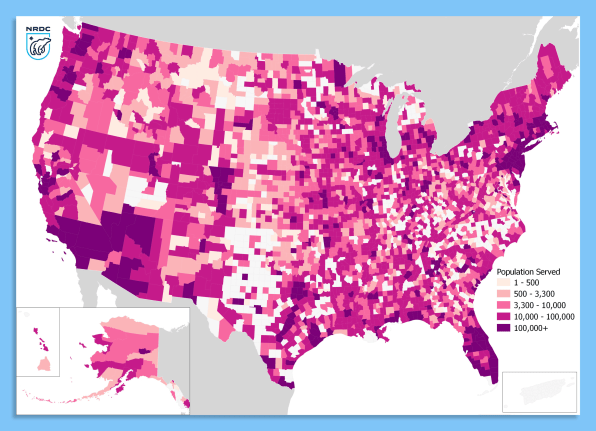Map: Is there lead in your drinking water?
One map shows water systems where lead levels have topped 15 parts per billion, the trigger for an EPA rule that requires water utilities to take action to reduce lead. But that limit “isn’t a health protective standard,” she says. Another map shows places where samples showed five parts per billion of lead, the EPA limit for bottled water. A third map shows water systems where more than one part per billion was found, the limit that the American Academy of Pediatrics recommends for drinking fountains in schools. No amount is okay. “The only safe amount of lead is zero parts per billion,” says Pullen Fedinick. Even low levels of lead can cause brain damage in children; in adults, the neurotoxin is also linked to heart disease and reduced fertility.
More than 18,000 community water systems, serving more than 186 million Americans, had some water samples with lead levels over one part per billion.
If your city is on the map, it doesn’t automatically mean that your tap water is unsafe. The data comes from samples taken across different neighborhoods, where pollution levels vary. But because cities take a relatively small number of samples, it’s possible that lead levels are even higher in some houses. “If I’m only taking 100 samples in a place like San Francisco, or Chicago, or New York, that isn’t necessarily going to tell me absolutely about what’s happening within my system,” she says. “And we know that the reporting is incomplete in a lot of cases.” (In the first analysis NRDC did, Flint wasn’t reporting high levels of lead.) Water systems can test less frequently if they have good results—as infrequently as every nine years—but the situation can also change over time.

The Biden administration has proposed removing all of lead service lines, the pipes that connect water mains to individual properties, in the country. Pullen Fedinick says that it needs to happen. “If we want zero parts per billion, you have to get the pipes out of the ground,” she says. It has to happen in the right way; some communities have only partially replaced the pipes, since local water systems are only responsible for the lines leading up to a property line, not the lines that connect to a house. But a partial replacement can actually make the situation worse by disturbing a coating on the pipes that protects lead from breaking off. It’s critical to replace the full connection, she says, and also to replace the pipes inside old houses and apartment buildings. (In the meantime, residents can filter their water, though only some water filters remove lead).
And it needs to happen everywhere. “This is a problem that affects every state in the country,” she says. “It doesn’t matter which direction it went in the presidential election. It really is about investing in the health of the entire country.”
(19)



